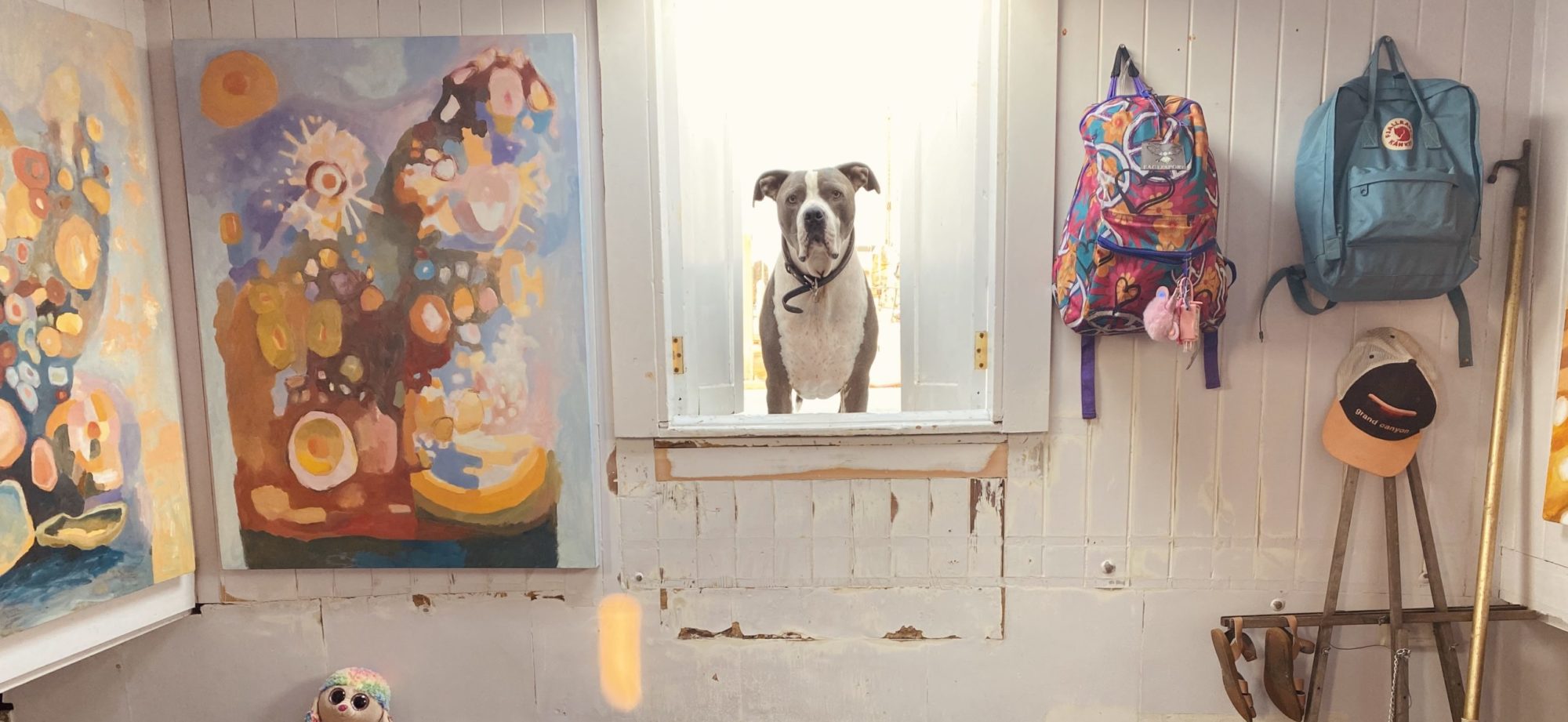Ford is rediscovering the coast and he asks to go back, time and again, to Santa Cruz. However, I’ve blissfully started introducing him to different shoreline habitats and today I figured was the perfect time to indulge myself, and the kids, in a low tide experience along the rocky surf at Moss Beach. I’d actually never been before. As it turns out, the park is a refuge for the Harbor Seal, who swims between this beach and the harbor, in lower Moss Beach; and, during low tides, this is the safest refuge for them to rest, atop the black rock that crops up through the crest of low tide. In fact, the rangers set up construction cones around the rim of the beach to give the seals privacy. Otherwise, they might flee the beach and swim to exhaustion, unable to find the refuge they need anywhere else along this shoreline.
We had just reached the beach, at the end of a short trail, when the camera battery died.
Ford was so anxious to recall what we saw today once we returned to the hotel. He quickly synopsed the visit with a drawing of his favorite finds (which deserved better light when I took this photo, but this will have to do):
With a stick, we had turned over an organism in the sand that resembled an enormous, wide cow tongue. On the underside of the orange beast, a flat foot with a central groove, in the shape of a U. On the backside, a row of partially hidden plates under thick hide-like orange flesh. A chiton relative? A grapefruit from outer space? Actually, I was right: Cryptochiton or Gumboot chiton (named after the color and texture of its flesh). Way cool, but also very dead and intensely rank. Next!:
Ford’s favorite of the day: the Green Sea Anemone. He discovered that he could stick his finger into the flowery nubbins and make them close up, squirting water out in a tiny little stream clear up to his nose. Very entertaining, he did this for the longest time until the tide started swallowing us. But not before we investigated Turban snails and rescued a parching Pisaster.
The Quilts of Gees Bend: The Soul of the Quilt
I arrive in Houston at six o’clock, scarf down a plate of italian sausage and spaghetti and my parent’s house, and escort mom to the Gees Bend exhibit at the MFAH. We have an hour before the museum closes and I get momenntarily lost navigating my way to the museum’s new addition, through the same corridors I used to browse with a trail of small children in my teaching days at the Glassell School, across the street. It’s embarrassing and I smile to an Asian security guard who doesn’t seem to remember me this time.
The glossy terrazzo floor reflects little observational discussions, the tapping of fancy shoes and the muted cast of each bold, vibrant quilt in this collection. And boy, are they something. If the colors and assymetry of the quilts don’t immediately make you smile, look closer.
If you have a sensitive conscience, then you have questioned the way we live today: the overlooked luxury in each car parked in the driveway and the way you can choose your way each day, the piles of fashion magazines and the excess clothes, garages filled so full of crap because the house is spilling over and space is limited– this is the typical American family way of life (not that I am the exception) and this is a way of life that starves people of happiness and groundedness and peace. I think about this a lot and was brought to tears when I listened to an interview with one of the quilters as I scrutinized a soulful patch of denim in a quilt, a piece taken from a pair of worn-out blue jeans, that included the dark blue ghost of a pocket, the reminder of the fabric’s former life. I wanted to run my hands along the seams, feeling the backbone of handiwork and sweat and conversation that birthed these colorful objects. I cradled the idea of reuse, inspiring the happy purist in me.
I thought about the stiff smell of rows upon rows of fabric bolts, the angst of shopping for the perfect hue, specialty scissors and quilting stores with basketfuls of fat quarters in every imaginable print: cats drinking milk, cats dancing, cats pouring milk, cats stargazing, cats chasing balls of yarn, cats chasing mice, cats napping, cats making me dizzy with a cascade of possibilities, for some reason(pardon me if cats are your thing–and I still think cats are cool). I thought about my own sleeping, shelved monster of a fabric stash. I thought of the closetful of clothes in my bedroom that I will never wear again but refuse to give away, holding them for some special deconstruction but not finding the time just yet. And so they sit there, looking stale. And smelling about the same. I think I vowed right there to boycott the purchase of any more fabric from a store or supplier for a good, long time–at least until I can manage to recruit much of what I already have. You know the old adage, Waste Not, Want Not. I mean, I value the use of new fabric for projects (and man, can some of you SEW!) but for now, I will value myself more if I downsize.

Plummer Pettway 1918-1993 “Roman Stripes, variation (local name: “Crazy” Quilt) cotton twill, denim, cotton/ polyester blend, synthetic knit (pants matieral), 86 x 70 inches.
These isolated women had only the outgrown and worn-out clothes and bolts of local fabric (I think Sears once gave them bolts of the avocado fabric that shows up in nearly one hundred of the collection’s quilts). One of the quilters, in the interview I was listening to, struggled as she tried to convey what it was like not to have much of anything to work with. Work shirts, blue jeans, feed sacks–nothing was wasted. Nothing.
I smiled to read little excerpts about the children, sitting on the front porch beneath the quilting table, watching the needle poke through the underside of the quilt. I told Ford about the way the children (who became the artists of these quilts) picked up scraps of fabric that had fallen to the floor and began making little quilts of their own, right there on the floor. “We didn’t have much, but we was happy” echoed similarly among them. And I still get tears to remember one woman share her surprise in knowing that someone else besides herself appreciates them, not to mention put them up on a wall.

Missouri Pettway, 1902-1981. Blocks and strips work-clothes quilt, 1942, cotton, corduroy, cotton sacking material, 90 x 69 inches. Missouri’s daughter Arlonzia describes the quilt: “It was when Daddy died. I was about seventeen, eighteen. He stayed sick about eight months and passed on. Mama say, ‘I going to take his work clothes, shape them into a quilt to remember him, and cover up under it for love.’ She take his old pants legs and shirttails, take all the clothes he had, just enough to make that quilt, ahd I helped her tore them up. Bottom of the pants is narrow, top is wide, and she had me to cutting the top part out and to shape them up in even strips.” –both quilt images from Auburn Universitys: Quilts of Gees Bend in Context’s website.
SPC: Pop Art: week 1
Summer is saturated with mass-production. The sun destroys anything left outside. So after lingering twilight, chasing fireflies and each other around the flowerbeds, toys stay outside night and day. Our home has stretched out onto the lawn. Plastic toys will only last a few months in this climate.
This is an inflatable swimming pool that I bought last summer. I also bagged sand toys, beach balls and a Slip and Slide, but these have all been shuffled into the other toys, buried in sand and punctured by piercing UVrays. This pool has lasted longer than I imagined, knowing when I bought it that it would destruct by Fall, like summer plastic tends to do.
It’s beginning to get a fair amount of use, now that we’re baking our way towards the double digits. And every day we drain it, like I’m doing (with Ford) in the photo above. I don’t have time for stylized puns on Pop art. Take this as a nod to mass production. We like it. Well, maybe not, but it’s convenient and cheap and beautiful when you’re short on cash. And who isn’t, when you majored in Industrial Design in school?
And you can see more Pop art self portraits here.
Speaking of mass-produced: balloons. They are in high demand at our home. Chas loves them. We can drive by Blockbuster (our fallback now that all of our Netflix movies have gone awol) and Chas will scream for boobahs. BOOBAH!!?!? BOOBAH?! BOOBAHH?! like some heroin addict. JUST! ONE! FIX!!!
We brought home two of the Blockbuster balloons with us on Friday, and Ford picked one up to practice the properties of static electricity.
So he rubbbbbbed the balloon on his nappy hair a minute and then I watched him hold the balloon over a small mount of sugar. The sugar flitted excitedly on the table. “A sugarstorm, mom!” He passed the balloon over a pile of punched paper holes: “Dancing dots, mom!” and then he passed the balloon over an ant trail in the kitchen: “Mom! Check it OUT!” And, sure enough, the ants were flicking up onto the balloon. Can you see them? They’re tiny pharoah ants (otherwise known as ‘Piss Ants’ by my father in-law, the entomologist). Science is so funny.

